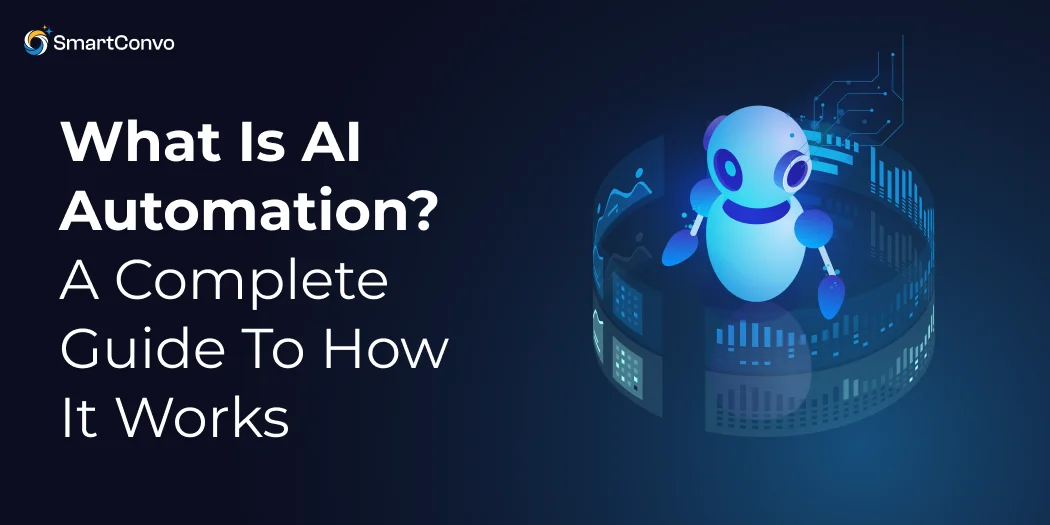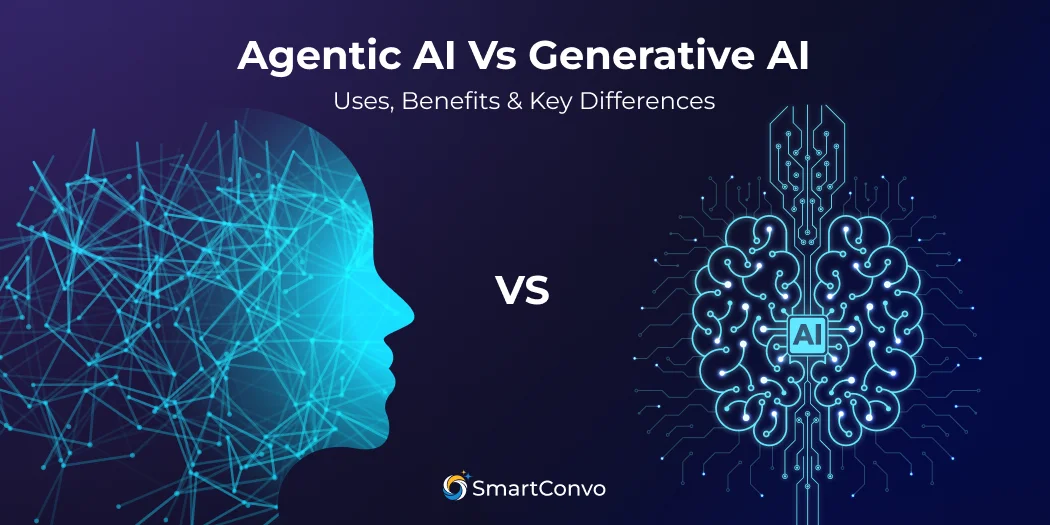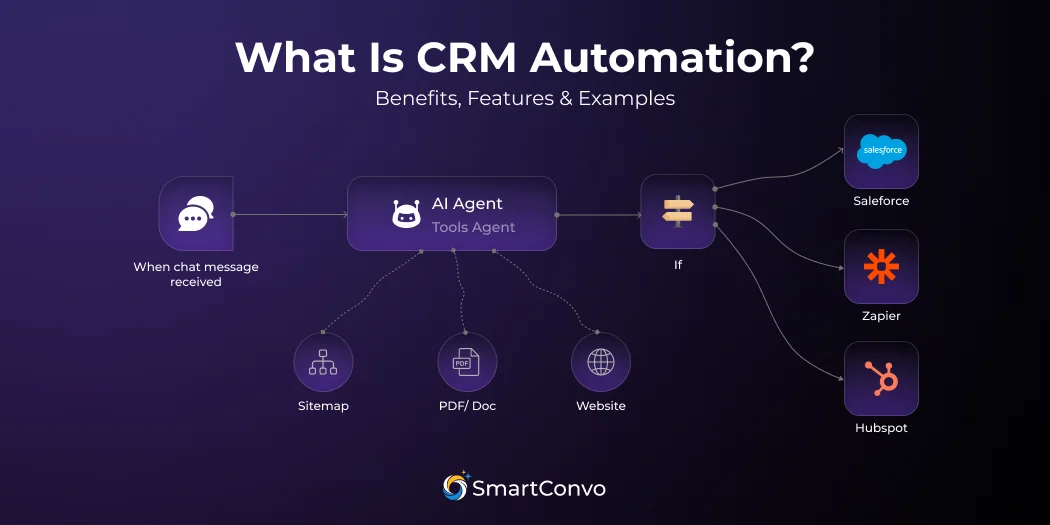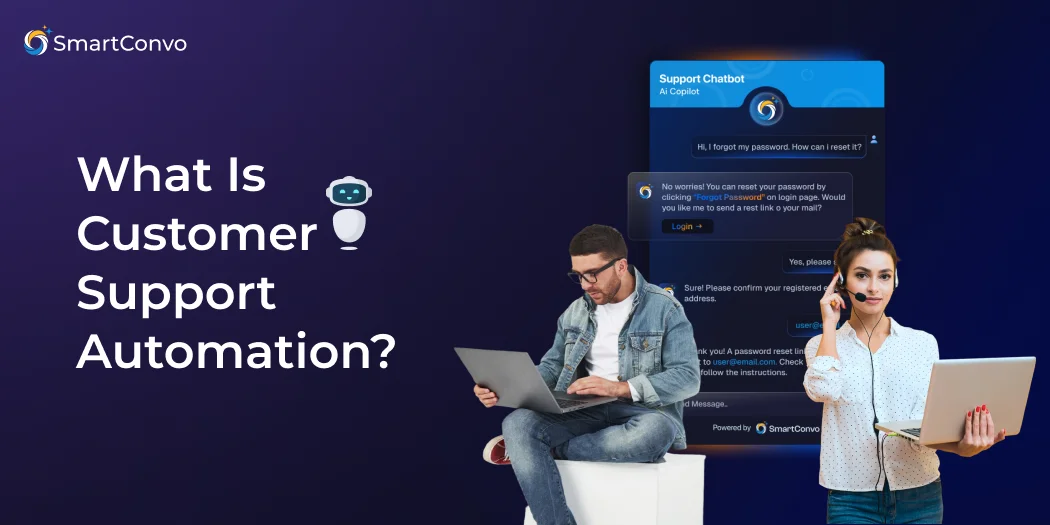Artificial Intelligence (AI) and automation are transforming industries at an unprecedented rate, driving efficiency, innovation, and better decision-making. But what happens when you combine the two? AI automation merges the intelligence of AI with the efficiency of automated processes, redefining how businesses operate.
Small business owners, marketers, and tech enthusiasts often hear buzzwords like AI automation and wonder what it all means for their operations. This guide will break it all down. From understanding the basics to exploring real-world applications and benefits, this guide will help you uncover how AI automation can revolutionize workflows and improve your business outcomes. Get ready to explore what AI in automation is, its pivotal role across industries, and how to leverage it for success.
What Is AI Automation?
At its core, AI automation is the combination of artificial intelligence and automation technologies to perform tasks and processes with limited human intervention. Traditional automation operates based on a set of pre-defined rules, while AI introduces the ability to learn, adapt, and make decisions based on data.
For example, traditional automation might handle repetitive tasks like sending invoices, but automation AI takes it one step further. It can analyze payment history and send reminders only to customers likely to delay payments. This combination allows businesses to evolve beyond static processes to more intelligent and dynamic workflows.
What Is the Difference Between Artificial Intelligence and Automation?
Though often used interchangeably, artificial intelligence and automation are two distinct concepts.
Automation
- Refers to software or machinery that operates based on pre-defined rules or scripts.
- Handles repetitive and structured tasks like data entry, invoicing, or workflow management.
- Examples include Robotic Process Automation (RPA).
Artificial Intelligence
- Enables systems to mimic human intelligence.
- Uses techniques like machine learning, computer vision, and natural language processing to analyze and adapt based on data.
- Examples include recommendation engines or generative AI.
AI Automation
When combined, AI automation systems deliver smarter, adaptive solutions that go beyond standard automation. It bridges the gap by enabling systems to not only perform tasks but also improve their performance through learning.
How Does AI Automation Work?
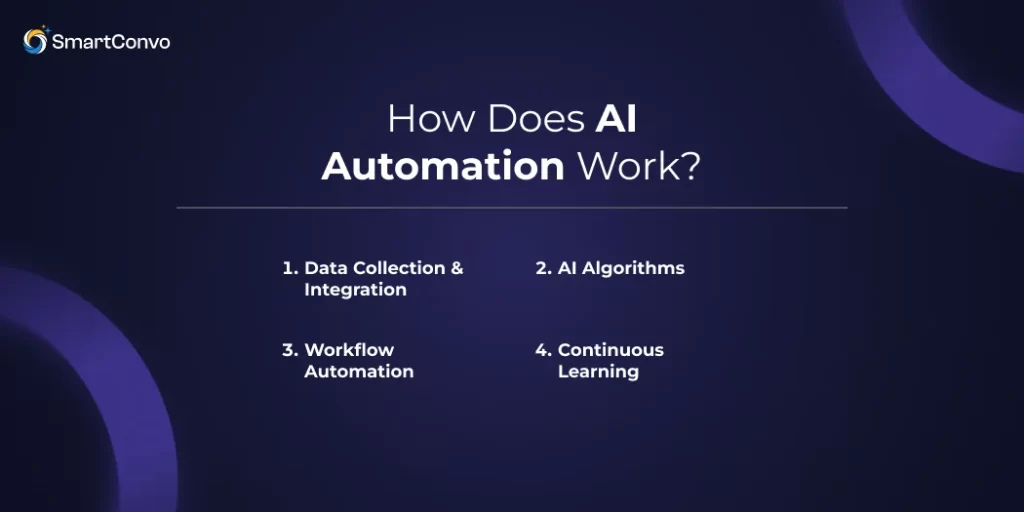
AI automation operates through a combination of advanced technologies, including machine learning, data integration, and workflow automation. Below is a breakdown of its key components.
1. Data Collection & Integration
AI systems rely on vast amounts of data to learn, adapt, and operate effectively. This data can come in various forms, such as structured data like spreadsheets and databases, or unstructured data such as text, images, and videos. To make sense of this information, AI integrates and processes it using tools like knowledge base for HR platforms, enterprise databases, and advanced data analytics software.
2. AI Algorithms
Machine learning algorithms and deep learning models are deployed to process vast amounts of data, enabling systems to perform complex tasks with remarkable accuracy. These algorithms analyze data to identify patterns, uncover insights, and make informed predictions based on previous trends. In some cases, they can even generate new content, as demonstrated in systems like generative AI integration,
3. Workflow Automation
Once the AI has performed its task, automated workflows ensure the results are applied efficiently and seamlessly. For example, in HR knowledge management, processes such as organizing employee records, conducting automated document reviews, or scheduling interviews can be greatly streamlined.
4. Continuous Learning
AI automation doesn’t stop once the task is complete. Instead, it continuously evolves by using feedback loops and incorporating new data to refine its performance over time. This continuous learning mechanism allows AI-powered systems to adapt to changing conditions, improve accuracy, and deliver better results with each iteration.
Types of AI Automation
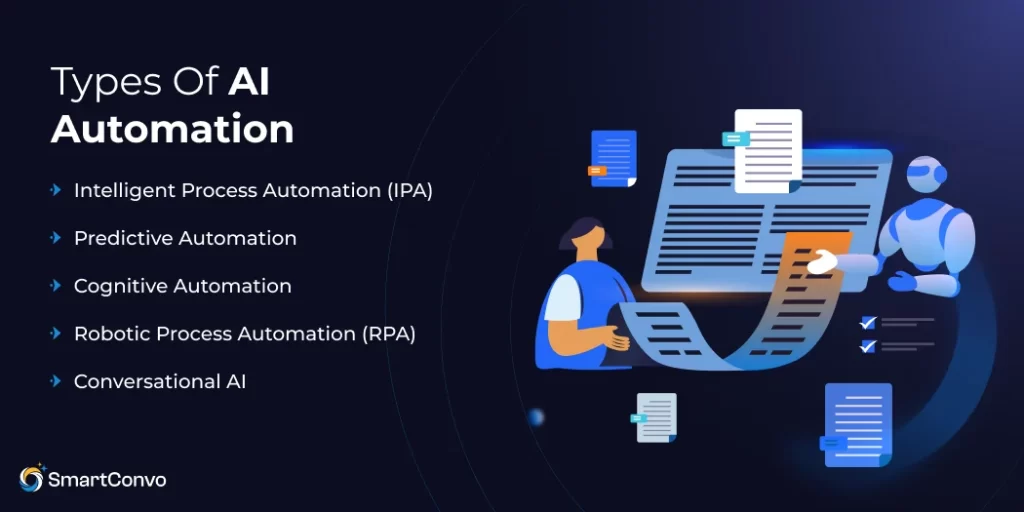
AI automation isn’t a one-size-fits-all solution. Different types of AI automation cater to varying business needs. Here’s a closer look at the key types you should know.
1. Intelligent Process Automation (IPA)
Combines advanced AI capabilities with powerful automation tools, such as Robotic Process Automation (RPA), to streamline and manage end-to-end business processes. This approach reduces the need for human oversight, increases efficiency, and ensures tasks are completed with speed and accuracy, making it ideal for scaling operations.
2. Predictive Automation
Uses advanced predictive models and data analytics to forecast a variety of outcomes, such as potential supply chain delays, customer churn rates, or sales trends. These insights help businesses make proactive decisions and improve overall efficiency.
3. Cognitive Automation
Mimics human cognitive abilities like reasoning, decision-making, and learning to solve complex problems and perform tasks traditionally requiring human intelligence. Cognitive tools are designed to analyze data, adapt to new information, and provide actionable insights. These tools often power applications such as AI sales chatbots, which engage customers with personalized recommendations, or conversational AI in HR.
4. Robotic Process Automation (RPA)
Robotic Process Automation (RPA) focuses on automating simple, repetitive, rule-based tasks, such as processing refunds, managing data entries, or handling routine customer service requests. These systems excel at improving efficiency and reducing human error in tasks that follow clear, predefined rules. However, when paired with artificial intelligence automation, RPA systems become significantly smarter and more adaptive.
5. Conversational AI
Includes technologies like llm chatbot and AI assistants, which are designed to enhance customer service by engaging users in intelligent, human-like interactions. These tools can handle a wide range of tasks, from answering common questions to providing personalized recommendations, making customer support faster, more efficient, and highly scalable.
Examples of AI Automation Across Industries
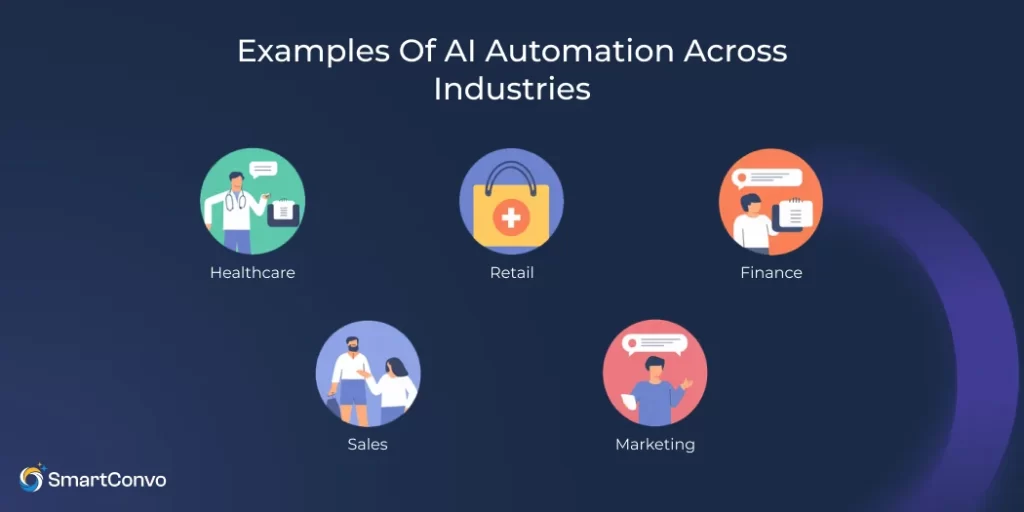
AI automation is being adopted across multiple industries. Here are some real-world examples showcasing its potential:
1. Healthcare
AI automation plays a crucial role in modern healthcare, assisting in medical imaging, diagnosing diseases, and processing patient data with speed and accuracy. For instance, advanced tools like Document AI for Knowledge Management can efficiently organize and analyze patient records, ensuring that vital information is easily accessible. This not only streamlines administrative tasks but also improves communication and collaboration among medical teams
2. Finance
Banks are increasingly leveraging AI automation to enhance their operations in several key areas. For fraud detection, AI algorithms analyze transaction patterns in real-time to identify unusual activity and prevent security breaches. Customer service has been transformed with LLM-based chatbots that provide instant, 24/7 support, answering queries and resolving issues efficiently.
3. Retail
Retailers now leverage AI-powered automation to analyze customer behavior, such as browsing patterns, purchase history, and preferences, to recommend products tailored to individual needs. This technology helps create highly personalized shopping experiences, enhancing customer satisfaction and driving sales by offering relevant suggestions at the right time.
4. Marketing
AI in marketing streamlines tasks such as customer targeting, content creation, and campaign optimization, making processes more efficient and effective. By analyzing vast amounts of data, AI identifies audience preferences and behaviors, allowing businesses to craft personalized and relevant campaigns.
5. Sales
Sales teams are increasingly leveraging AI-automation to streamline their workflows and improve results. From pipeline analysis and lead scoring to enhancing customer engagement, AI tools are transforming the sales process. For instance, a sales chatbot can handle initial customer inquiries, provide personalized recommendations, and even assist in converting leads into clients, freeing up valuable time for sales representatives to focus on closing deals.
Benefits of AI Automation for Businesses
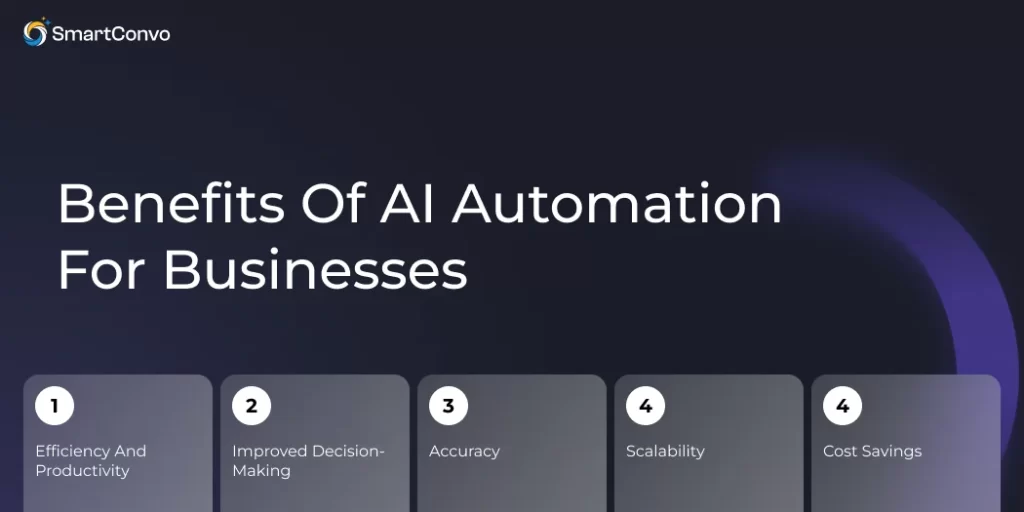
Organizations leveraging AI automation consistently report significant competitive advantages, including:
1. Efficiency and Productivity
AI automation significantly accelerates repetitive and time-consuming tasks, such as data entry, scheduling, or basic customer support. By handling these routine activities efficiently, it frees up employees to focus on more strategic and creative projects that add greater value to the business, driving innovation and productivity.
2. Improved Decision-Making
By analyzing vast amounts of data from various sources, AI generates actionable insights that empower business leaders to make well-informed decisions. These insights can uncover hidden patterns, predict future trends, and optimize processes, ultimately driving better strategies and improved outcomes for organizations.
3. Accuracy
Automation minimizes human error by streamlining repetitive and time-consuming tasks, such as data entry or invoice generation. By relying on automated systems, businesses can ensure greater accuracy, reduce costly mistakes, and save valuable time that can be redirected toward more strategic activities.
4. Scalability
AI automation enables businesses to handle larger workloads without needing to increase resources, such as staff or infrastructure. By streamlining repetitive tasks and improving efficiency, companies can focus on scaling operations and meeting growing demands while maintaining cost-effectiveness.
5.Cost Savings
By reducing the need for manual intervention, companies save on labor costs and minimize operational inefficiencies, allowing teams to focus on higher-value tasks. This not only improves productivity but also enhances overall workflow efficiency, paving the way for scalable growth and long-term success.
Which AI Is Best for Automation?
The best AI solution will depend on your specific business goals and needs. Enterprise AI solutions, such as IBM Watson and Google AI, deliver powerful tools designed for large-scale operations, offering advanced machine learning capabilities, data analytics, and automation to streamline complex processes.
On the other hand, user-friendly platforms like Jasper are ideal for tasks like content creation, marketing, or workflow management, providing intuitive interfaces and accessible features that don’t require extensive technical expertise. By understanding the strengths of each platform, businesses can select the right AI solution to drive efficiency and innovation.
Challenges of Automating with AI
Despite the benefits, implementing AI automation is not without challenges:
- High Initial Costs: Setting up AI systems can be costly, requiring significant investment in both hardware and software, as well as the expertise needed to develop, implement, and maintain the technology.
- Skills Gap: Employees may require additional training to effectively work alongside AI tools, ensuring they understand how to use these technologies efficiently and integrate them into their daily tasks.
- Data Privacy Concerns: AI relies heavily on data to function effectively, but improper handling of this data can result in serious privacy breaches. Ensuring data is collected, stored, and processed securely is critical to maintaining user trust and preventing misuse or unauthorized access.
How to Get Started with AI Automation
1. Identify Your Needs
Start by analyzing which business processes would benefit most from AI automation solutions. Look for tasks that are repetitive, time-consuming, or prone to human error, as these are often the best candidates for streamlining through automated solutions.
2. Choose the Right Solution
Discover AI platforms tailored to meet your specific business needs, helping you streamline operations, improve efficiency, and drive innovation.
3. Start Small
Start by focusing on a single department to implement your AI automation strategy or solution. This allows you to test its effectiveness, demonstrate measurable ROI, and refine the process if needed. Once successful, you can confidently scale the approach to other departments or across the entire organization.
4. Train Your Team
Ensure team members are properly trained and equipped with the skills needed to manage, collaborate with, and effectively utilize AI systems in their daily tasks. This includes understanding how AI works, leveraging its capabilities, and addressing any challenges that may arise.
5. Monitor Progress
Continuously track the performance of AI systems to ensure they are meeting expectations and delivering accurate results. Regularly analyze their outputs, identify any inconsistencies or areas for improvement, and make the necessary adjustments to optimize their functionality over time.
What Does the Future Hold for AI Automation in the Workplace?
The future of AI automation is filled with immense promise, shaping the way businesses operate and innovate. Technologies like knowledge in AI, which enables systems to understand and utilize complex datasets, and generative AI, which enhances workplace performance by streamlining tasks and providing creative solutions, are rapidly advancing. These technologies are not just tools—they’re becoming integral to how companies achieve their goals.
From enabling hyper-personalized customer experiences through real-time data analysis to fully automating resource-heavy processes like logistics, content creation, and customer support, automation in AI is set to redefine how work gets done across industries. By reducing manual effort and increasing efficiency, businesses can allocate more resources to strategic growth, innovation, and building stronger connections with their audiences. As AI continues to evolve, the possibilities for transformation seem limitless, opening doors to a smarter, more efficient future.
No Credit Card Required | 14 days Free Trial
Build Your Chatbot
Conclusion
AI automation has the potential to completely transform your business operations, driving efficiency, reducing costs, and enabling smarter, data-driven decision-making across all areas. Whether you’re implementing conversational AI to enhance customer service or scaling up with advanced LLM-based chatbots to handle complex interactions, the opportunities for growth and innovation are endless. From streamlining repetitive tasks to boosting productivity, AI can revolutionize the way you wor
Frequently Asked Questions (FAQ)
AI process automation combines AI and automation to execute complex tasks intelligently.
AI mimics human intelligence through algorithms that analyze data, learn patterns, and make decisions.
AI automation is used in industries such as healthcare, finance, retail, and marketing.
Yes, ChatGPT is an AI agent powered by Agentic AI, capable of natural language processing and assisting users.
AI robots use sensors, machine learning models, and algorithms to perform physical tasks autonomously.




